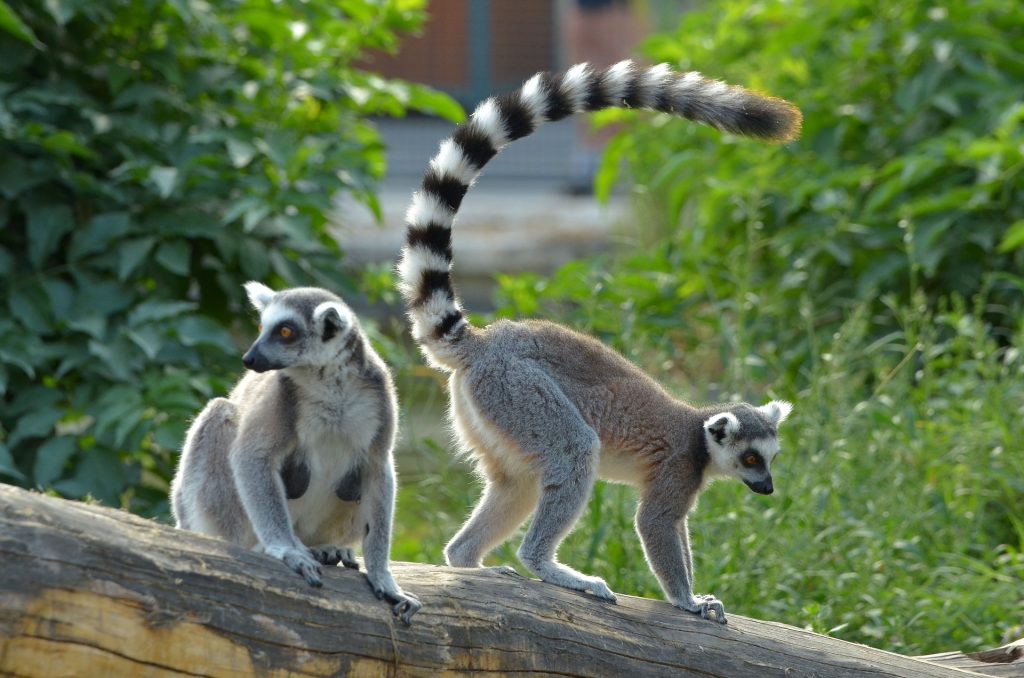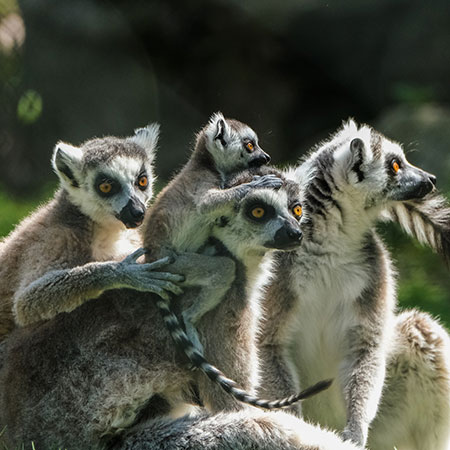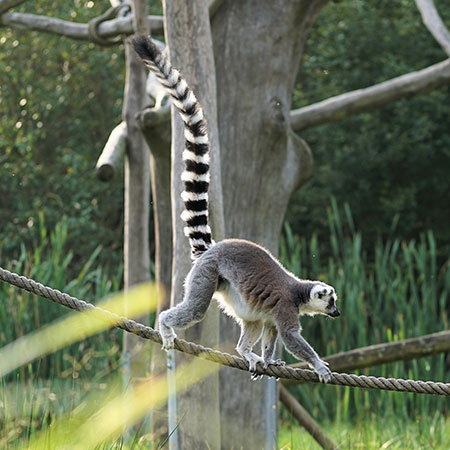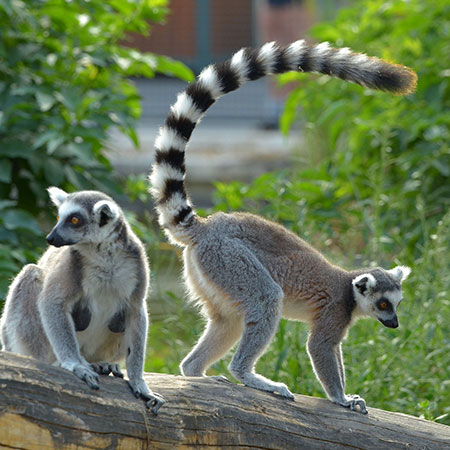General Information
Ringtail Lemurs are primates. They live mostly in treetops in groups known as troops. The Ringtail lemur have scent glands on their wrists and bottoms that leave scent trails on branches to mark their territory. They are social animals and spend a lot of time grooming and playing with each other.
Size
The Ringtail Ring-Tailed Lemurs have a body length of 15-18 inches their tail is about 22-25 inches. The average weight is approx. 4.9-6.6 pounds.
Appearance
Their bodies are gray to rosy brown with white bellies. Their heads and necks are dark gray. Their faces are white with triangular dark colored eye patches. Their tails are ringed in color alternating white and black. Their nails are human-like. Their fur is soft and thick.
Lifespan
The ringtail lemur can live 16-19 years in the wild and over 30 years in captivity.
Habitat
They live in the rainforests, lowlands, scrublands and rock canyons of south and southeastern Madagascar.
Diet
They are omnivores, they eat leaves, bark, fruit, flowers, insects, sap and small vertebrates.
Reproduction
Females reach sexual maturity at approximately 2-2.5 years while males reach theirs at about 2.5-3 years. Gestation is approx. 134-144 days. Females give birth to one but occasionally have twins. Breeding is once a year. https://ielc.libguides.com
Other facts
The Ringtail Lemur live in groups. They communicate with each other by using vocalizations and scent marking. The adult females are dominant over the males. They are active in the morning and late afternoon and enjoy an early afternoon nap.




Basic Care
Feeding
The Ringtail lemur is omnivorous. They eat a variety of vegetables, fruits, flowers leaves, herbs and small vertebrates. They can be fed several times a day, you can provide variety by cutting their food into small pieces, providing them with food puzzles to encourage foraging. Provide them with a variety of food including leaf-eater biscuit’s. You will also need to provide them with an adequate amount of Vitamin D. As a baby we use Ebsilac Sensitive with rice cereal and a scoop of baby banana food. We also offer a small dish cut of fruit mixed with the formula and fresh water.
Water
Also provide fresh water. We use a water Lixit which is very easy to clean and provides them with fresh water daily.
Cleanliness
Clean the enclosure daily.
Enclosure
A Ringtail lemur enclosure must be large enough for the group of lemurs. It must have enough perching areas and nest boxes. They must be large enough that all of the lemurs can occupy at the same time. The enclosure should encourage all of their natural behaviors. Provide them access to outdoors and natural sunlight and protection from the weather. The enclosure must also be secure to keep them from escaping or from predators getting in. If you keep your lemur inside make sure that it is lemur-proofed. Ceiling fans can be dangerous to your animal.
Temperature
Ringtail lemurs live in a tropical environment. You will need to make sure that their den is heated in the winter. Make sure they have nesting boxes that they can climb into in order to stay warm. You may also need to add a heating source but ensure
Exercise
The ringtail lemur will get exercise by running, jumping and playing with other lemurs.
Handling
You can train ring-tailed lemurs using positive reinforcement training.
Toileting
You can diaper them if you wish but they cannot be potty trained or liter trained like a cat.
Enrichment
Lemurs love to live in groups. You can provide enrichments for mental and physical stimulation such as balls, swings, mirrors. Human interaction is a daily must. They also love food puzzles and provide them with areas that they can hang upside down and stretch. Young lemurs need to learn the social dynamics of their group and will find their place in the hierarchy Make sure that you spend lots of time with your baby lemur as it is important to imprinting.
Requirements
For one or two Ringtail Lemurs you are required to have a cage or enclosure that is 4ft by 5ft and 6 feet tall. For each additional animal you must increase the enclosure size by 25% of the original floor are Each enclosure must have nesting box or boxes and perching areas that can accommodate all of the animals in the enclosure at one time. Each enclosure also must have a climbing apparatus.
In addition to the above mentioned each enclosure must have noninjurous physical and mental stimulating enhancement compatible to the species. Can include but is not limited to balls, mirrors, foraging items and boxes.
